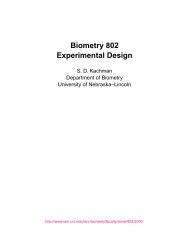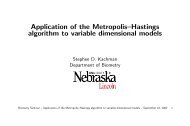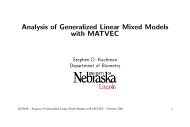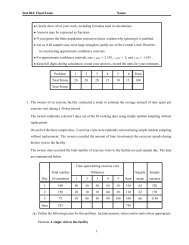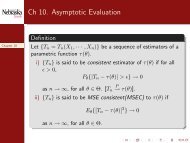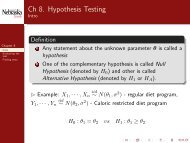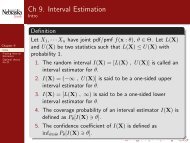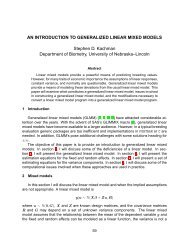Matvec Users’ Guide
Matvec Users' Guide
Matvec Users' Guide
- No tags were found...
Create successful ePaper yourself
Turn your PDF publications into a flip-book with our unique Google optimized e-Paper software.
3.3. MANIPULATION 17<br />
3.2.2 Relational operators<br />
There are six relational operators, they operate between two objects.<br />
== equal to<br />
!= not equal to<br />
< less than<br />
> greater than<br />
= greater than or equal to<br />
These six operators are based on element-by-element comparison. It returns a matrix with resulting<br />
element(i,j) = 1.0 if the relationship is true, otherwise resulting element(i,j) = 0.0<br />
3.2.3 Logical operators<br />
There are two sets of logical operators: (&&, ||) and (.&&, .||).<br />
The && is a short-circuit logical operator AND. A && B returns 1 if both A and B are true (B is evaluated<br />
only after A is true), otherwise return 0. If A (or B) is a matrix, then A.all().all() is implicitly applied. If<br />
A (or B) is a vector, then A.all() is implicitly applied. Any other types of objects will be determined false.<br />
The || is a short-circuit logical operator OR. A || B returns 1 if either A and B are true (B is evaluated<br />
only after A is false), otherwise return 0. If A (or B) is a matrix, then A.all().all() is implicitly applied. If<br />
A (or B) is a vector, then A.all() is implicitly applied. Any other types of objects will be determined false.<br />
The .&& and .|| are the same as && and || except that 1) the former is performed element-by-element,<br />
2) the former is non-short-circuit, thus both operands will be evaluated.<br />
For readability, <strong>Matvec</strong> creates synonyms AND and OR for && and ||, respectively.<br />
3.3 Manipulation<br />
Matrix manipulation is a tricky work. Basically, there are three kinds of manipulations: 1) accessing elements<br />
and sub-matrices, 2) adjoining and stacking, 3) selecting elements which satisfy whatever condition you<br />
specify. They are described below in detail.<br />
3.3.1 Accessing element and sub-matrix<br />
• accessing an element<br />
A(i,j) accesses (i,j)’th element with boundary checking<br />
• accessing a row<br />
A(i,*) gets a copy of the i’th row of matrix A.<br />
• accessing a column<br />
A(*,j) gets a copy of the j’th column of matrix A.<br />
• accessing sub-matrix<br />
A(i1:i2, j1:j2) returns a sub-matrix of A with row i1 through i2 and column j1 through j2. A([i1,i2,i3],<br />
[j1,j2,j3]) returns a sub-matrix of A with rows i1, i2, and i3 and columns j1, j2, and j3.<br />
For example,



